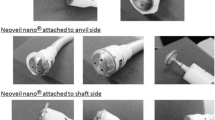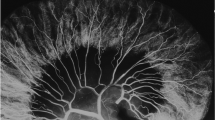Abstract
A Russian stapler and an EEA® stapler were used for end-to-end anastomosis of the canine descending colon. The vascular structures of the anastomotic sites were investigated for postoperative changes at two, three, four, five, and six weeks after anastomosis by using the resin-casting method, with a scanning electron microscope. The two techniques of anastomotic stapling led to the following differences: at two weeks or more following anastomosis, it was found that, compared with the EEA stapler, the site stapled with the Russian device showed a slightly more markedly irregular microvascular pattern of the capillary network in the mucosal membranes along the anastomotic suture line and what were believed to be microulcerations as well. Samples of the Russian stapler at two and three weeks postoperatively showed that the fault zones had developed in the vascular casts of the mucosal capillary system between the area of irregular vasculature and the normal mucosa. It was clearly established, however, that the microvascular channels in the mucosal membrane of the anastomotic site across the orad and anad segments of the colon had already formed after two weeks with both of the stapling techniques. New microvessels grew within a range of about 10μ in diameter from the cut-off surface of the mucosa and united. No necrotic destruction of tissue or deficiency findings had manifested themselves in the inverted cuff zone of the anastomotic site, and the staple had been enveloped by the blood vessels of the submucosal layer and embedded in the intestinal wall during the period of two to six weeks. New microvessels, 10 to 15μ in diameter, were found to have already formed in the two-week samples, passing vertically across the lumen of the closed eye of the staple, and no differences in vascular structure were detected, depending on the different shapes of staples used. Five to six weeks after the anastomotic surgery, the mucosal membranes in the anastomotic site showed a normal vascular structure with only minute residual indentations.
Similar content being viewed by others
References
Shikata J, Shida T, Satoh S, Furuya K, Kamiyama A. The effect of local blood flow on the healing of experimental intestinal anastomoses. Surg Gynecol Obstet 1982;154:657–61.
Murakami T. Application of the scanning electron microscope to the study of the fine distribution of the blood vessels. Arch Histol Jpn 1971;32:445–54.
Abramowitz H, McAlister WH. A comparative study of small-bowel anastomoses by angiography and microangiography. Surgery 1969;66:564–9.
Wise L, McAlister W, Stein T, Schuck P. Studies on the healing of anastomoses of small and large intestines. Surg Gynecol Obstet 1975;141190–4.
Keane FB, Moore DJ, Byrne PJ, Hennessy TP. A comparison of circular stapling devices for rectal anastomoses: a study in dogs. Dis Colon Rectum 1982;25:285–8.
Fain SN, Patin CS, Morgenstern L. Use of a mechanical suturing apparatus in low colorectal anastomosis. Arch Surg 1975;110:1079–82.
Smith CR, Cokelet GR, Adams JT, Schwartz SI. Vascularity of gastrointestinal staple lines demonstrated with silicone rubber injection. Am J Surg 1981;142:563–6.
Author information
Authors and Affiliations
About this article
Cite this article
Shikata, JI., Shida, T. Experimental studies by the resin-casting method on the vascular structure of the colon following stapler anastomoses. Dis Colon Rectum 28, 341–346 (1985). https://doi.org/10.1007/BF02560437
Received:
Issue Date:
DOI: https://doi.org/10.1007/BF02560437




